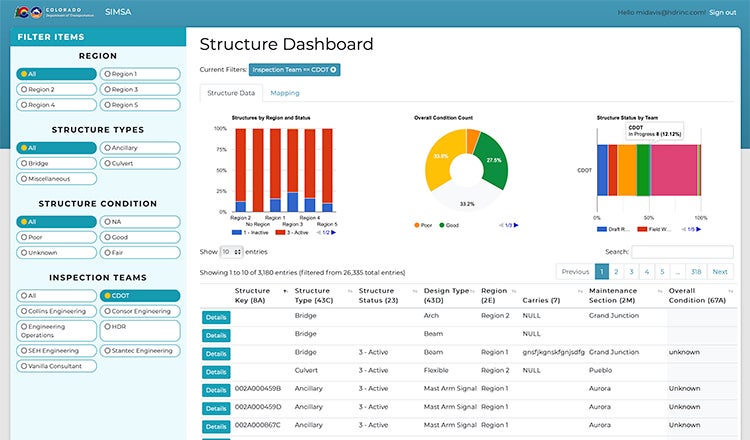System for Inspection and Management of Structural Assets (SIMSA)

System for Inspection and Management of Structural Assets (SIMSA)
State of the Art Tools for Managing Colorado’s Transportation Structures
The Colorado Department of Transportation maintains more than 9,000 bridges statewide. Tracking those, along with the thousands of culverts, walls, tunnels and other structural components of its system, is a gargantuan task.
To more efficiently manage the inspection and maintenance of these structures, HDR partnered with CDOT to develop the System for Inspection and Management of Structural Assets, or SIMSA. This asset-management system empowers CDOT as they plan for the full life cycle of their structures. It includes management of asset data such as photos and documents, tracks historical bridge condition changes and recommended maintenance activities, and importantly, it can be accessed and updated either on the web or in the field.
Designed for Flexibility and Functionality
The system replaced the AASHTOware Bridge Management software system used on many of CDOT’s inspections. SIMSA has structure specific inspection processes for bridges, culverts, tunnels, walls and ancillary structures on the CDOT system. SIMSA is built on industry-standard and open-source technology, including Microsoft.NET and Esri mapping tools, which allows CDOT to easily share, modify and build new capabilities without ties to a particular vendor or additional license fees.
The centralized database serves both a web-based management tool and a tablet-based field inspection tool. Developed and owned by CDOT, it eliminates ongoing subscription and licensing fees and allows for customization and further development. Built from the ground up with considerable input from those are using the system on a daily basis, SIMSA is also designed to evolve as bridge inspection needs change. For example, an upgrade is already underway to incorporate new FHWA reporting requirements (known as the Specifications for the National Bridge Inventory or SNBI) which will be ready for users in March of 2025. It builds on the best features of existing asset management systems, including inspector-specific workflow, streamlined data collection, automated collection and management of photos and documents, and customizable reports.

SIMSA is designed to assist those in multiple roles:
- CDOT project managers who oversee inspection work can monitor status, assign inspections, track their progress and perform QA/QC functions.
- Consultant project managers can do many of the same functions — assign and track inspections, perform QA/QC — and then submit inspections to CDOT for final review.
- Inspectors can use both the web interface and field app to carry out inspections. In the field, they can use the app to gather photos and begin reports. Additional documents can be uploaded from the office and submitted for further review.
- Agency business analysts can look up information on structures and inspections, manage documents and update work performed.
- GIS analysts can query and analyze structure data to build custom maps and dashboards, because SIMSA was built using CDOT’s standard SQL server and Esri technology.
SIMSA includes significant improvements from CDOT’s previous asset management system, including automated photo management, auto-calculation of inspection quantities, integrated GIS mapping, the ability to take photos with the inspection app, cloud hosting and more. The web-based tool can also be used by other interested agencies to retrieve inspection data that was not previously easily accessible.

Collaborative Software Development
As part of SIMSA’s development, HDR and CDOT worked with bridge experts from across the industry, and their feedback has driven the iterative development of a more efficient, user-friendly system. Because the user base was involved throughout the testing and development process, there has been little to no formal training required. The intuitive nature of the system has helped new users jump right in and be more productive both in the field and in the office.
The base of the system is the FHWA requirements that all states need to conform to and for which they must provide annual reports. However, it can be customized with state-specific preferences such as data fields, workflows and procedures. CDOT began using SIMSA for all its inspections in early 2024. Moving forward, CDOT plans to make the intellectual property behind SIMSA available to other agencies so that they, too, may benefit and further enhance the system.








